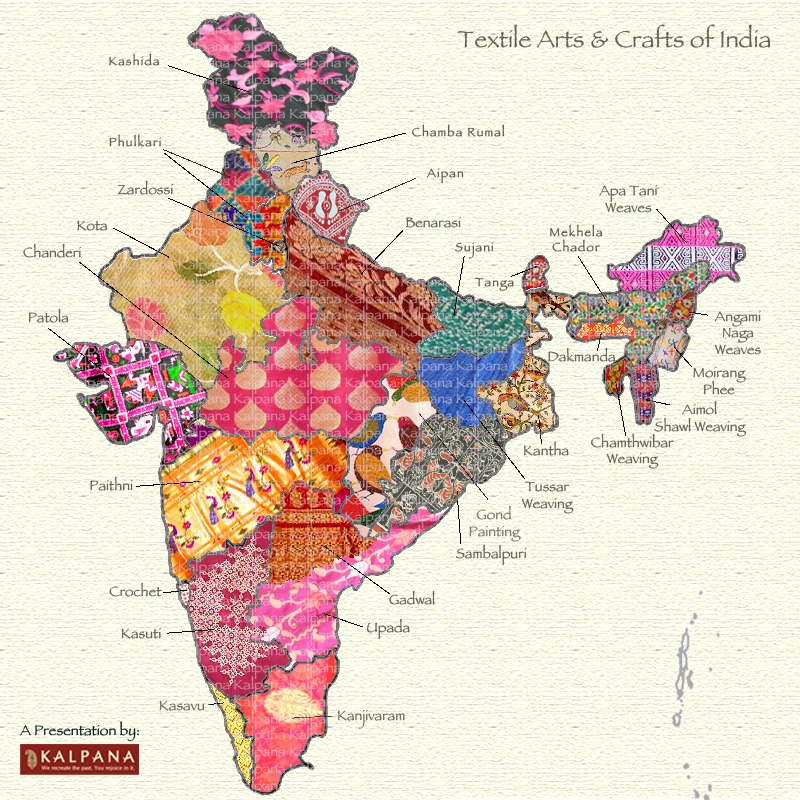ARTS and CRAFTS
TEXTILES
The manufacture
and use of various forms of fine textile varieties can be traced back
to the Indus Valley period. Due to the short life of the textiles,
the only evidences are the paintings, sculptures and inscriptions if
any. The images in the paintings and sculptures are seen draped
in fine transparent muslin. In fact, in most paintings the fineness
of the cloth is stressed by highlighting only the hem and folds of the
dress. There are clear evidences of the variety of textiles and embroidery
in the Ajanta murals and miniature paintings, temple murals.
The art of weaving and dyeing cotton had been well developed, but silk
weaving came later. The art was practised from 1st century and by
the 4th and 5th century, woven silk formed a major portion of exports.
Textiles were
the major attraction that formed the bulk of the trade with Western and
Eastern countries. Roman documents mention the export of silk from
India to Europe around the sixth century A.D. Masulipatnam on the
western coast was an important port, with traders coming in from China,
Arabia and European countries like Portugal, France and England.
Textile trade
was carried on in the North, with caravan loads of woven textiles reaching
Moscow. The Moghul Emperors with their flair for beauty and luxury
brought in new skills which mingled with the existing art, resulting in
fine artworks.
The textile
trade that had started diminishing with lack of strong Moghul rulers, totally
came to a standstill with the Industrial Revolution in England. In
their attempt to sell their wares, India was used as a dumping ground for
their cheap machine made textiles. Indian master weavers were out
of jobs. The Swadeshi Movement stressed the need for use of the hand
crafted Indian textiles, both to preserve the craft forms and also to protect
the interests of the Indian craftsmen.
After Independence,
efforts were made to revive the industry. In 1952, the All-India
Handicrafts Board was set up, with Smt. Kamaladevi Chattopadhyaya as the
chairman. The conditions were so pathetic with little or no information
available easily. Several programmes were launched to retrieve some
samples, to create an awareness amongst the public, to learn again to appreciate
the fine intricate art forms of our country. All their efforts have
paid off and today there is a great recognition, thanks to their efforts,
for the Indian textiles in India and abroad.
Heritage of the Loom - from "Homage to Rukmini Devi"
Kalakshetra - Weaving Centre
Traditional motifs used as a base design in weaving of South Indian textiles
Textile specialities by region
Paithani weaves, Maharashtra
Kalpana, Delhi have put together a window into the world of Textile
showcasing a microcosm of the various Textile Arts and Crafts across
our India.

facebook link
Ayurvastra - Natural ayurvedic herbal dyed textiles
Ayurvedic Textiles are made using natural fibers and dyed with medicinal rich herbs.
Ayurvedic fabrics are not only eco-friendly but also give wellness or positive energy to skin.
The process is unique from pre-processing to dyeing as only natural
herbs and plants are used for all the process - natural gums are added
to fix the properties of the herbs by infusion method. All the fabrics will have an energy and you can feel by using it.
GOTS certified fabrics are used and fabrics have normal standard
fastness. Customers are assisted to conduct the required test on the
fabrics.
Ayurvedic Demo program is organised every 2nd saturday in a month at Erode, Tamilnadu
Register to participate, visit the facility to understand more about the process.
Kairali Exports
Head Oce and Showroom
SN Lace Buliding, Balaramapuram, Thiruvanathapuram,Kerala - 695501
Ph: 0471 - 2400371 ; Mob:+91 9387803812
Ayurvedic Herbal Farm and Handloom Center
12/192,Thailampalayam, Olakkovil PO, Nambiyur,Erode - 638 460
Ph: 0421 - 3219777 ; Mob: +91 9020503812 ; email: ayurvastrainfo@gmail.com / contact@ayurvastra.in
https://ayurkruti.com/ayurvastra

Zari and thread work borders
Jayanth Kalamkari designs
Manufacturer and wholesaler of pure vegetable print
kalamkari sarees, fabrics, dress materials, kurtis, patch work kurtis
and sarees, shawls, bedsheets, table cloths, door curtains, wall panels -
non chemical and easy to maintain, long lasting and color fast.

Kalamkari - Krishna

Kalamkari - Wall panels

Kalamkari Patch works

Kalamkari Patch sets ; 2

Kalamkari Dupattas ; 2
The Andhra Pradesh State Handloom Weavers Cooperative Society Ltd., (APCO)
facebook link
|